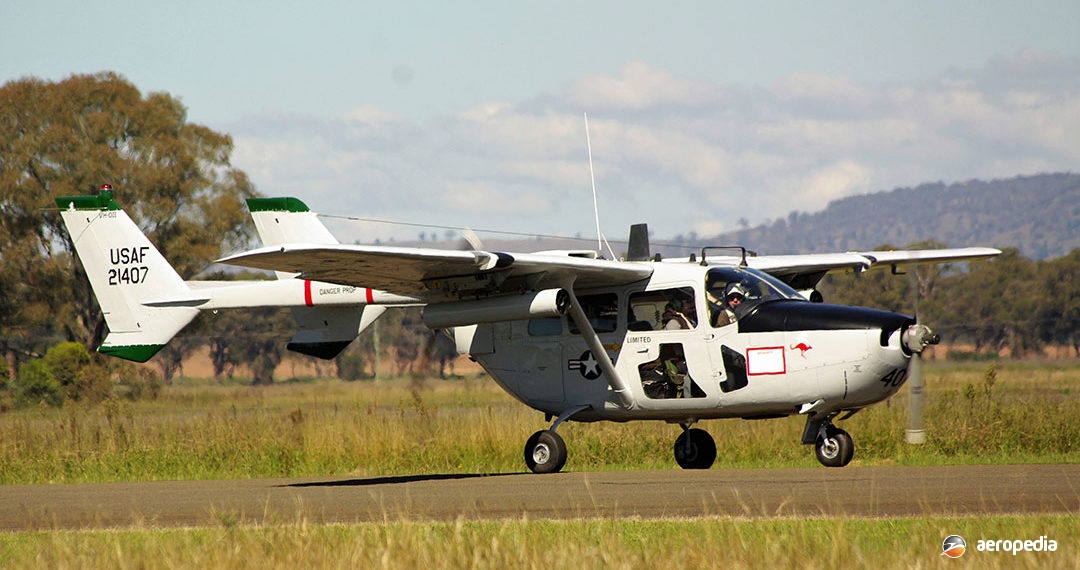Photograph:
Cessna O-2 VH-OII (c/n 337M0113) at Cowra, NSW (David C Eyre)
Country of origin:
United States of America
Description:
Forward air control and psychological warfare aircraft
Power Plant:
Two 157 kw (210 hp) Continental IO-360-D six-cylinder horizontally-opposed air-cooled engines
Specifications:
- Wingspan: 8.53 m (28 ft)
- Length: 8.9 m (29 ft 2 in)
- Height: 2.89 m (9 ft 5 in)
- Wing area: 18.8 m² (202.5 sq ft)
- Max speed (Vne): 353 km/h (219 mph)
- Cruising speed: 259 km/h (161 mph)
- Stalling speed: 109 km/h (68 mph)
- Initial rate of climb: 360 m/min (1,180 ft/min)
- Service ceiling: 5,182 m (17,000 ft)
- Fuel capacity: 462 litres (101.6 Imp gals)
- Empty weight: 1,383 kg (3,048 lb)
- Useful load: 817 kg (1,802 lb)
- Loaded weight: 2,200 kg (4,850 lb)
Armament:
Two 7.62 mm (0.30 in) mini-gun pods on underwing pylons
History:
A military variant of the Cessna 337, the O-2 series was built in some numbers, 501 Model O-2As going to the USAF for Forward Air Control (FAC) duties, and some 31 Model O-2Bs being used in the psychological warfare role in Vietnam. The Model O-2B aircraft had three loud-speakers and provision for leaflet dispensers. Others were delivered to the Imperial Iranian Air Force, these aircraft being fitted with four under-wing hardpoints for ordnance.
One adaptation of the series was marketed by Summit Aviation as the Sentry O2-337, this being a variant of the turbocharged T-337.
Some 82 examples of the O-2s were lost on operations and 22 to other reasons in Vietnam. They operated with the USAF with the the 9th Special Operations Squadron and the 19th, 20th, 21st, 22nd and 23rd Tactical Air Support Squadrons in Vietnam and Thailand, as well as a number of US-based training and Air National Guard Units.
For night operations the Cessna O-2 was capable of dropping flares for enemy detection using night-sight scopes. Most aircraft were painted grey with black upper cowl and the top of the wings were white. Some were painted gloss black for operations at night over the Ho Chi Min trail. They were capable of remaining airborne for a maximum of two and a half hours when fully loaded with rockets and with two pilots. When carrying one pilot and a lighter load they could remain airborne for nearly five hours.
After USAF service many finished their days with Air National Guard units. A number were used by the US Navy as target range spotting aircraft, eventually being replaced by the Beech T-34 Mentor.
Cessna developed a model known as the O-2TT (registered N6309F) with two Allison 250-B15 turboprop engines but this did not go into production.
A number of air forces operated the type, including Zimbabwe, these being French-built aircraft obtained in February 1976 by Rhodesia. Named Lynx, they were fitted with two 7.62 mm (0.303 in) machine-guns above the cabin and 37 mm SNEB rockets and small bombs. They undertook couner insurgency (COIN) and FAC duties during the long bush war in that country. Other operators included Sri Lanka, Ecuador, Mexico, the Chilean Army, Jamaican Defence Force, Haitian Air Corps, Thai Air Force, Costa Rica, Dominica, South Korea and El Salvador.
A number of examples of the O-2 have been imported to this region, including ex-US Air Force Vietnam veterans. One aircraft, an M337B, VH-OII (c/n 337M0113 – ex-67-21407 – ex N5257G) had a combat history, operating with the 20th US Tactical Air Support Squadron out of Da Nang between 1967 and 1971, suffering some damage from small-arms fire whilst operating in the FAC role on at least six occasions. On its return to the US it was flown by the 110th Tactical Air Support Group at Battle Creek Air National Guard Base in Michigan. It later went to the 105th Group. After retirement from the USAF it was converted for private use and won the “Best O-2” award at the 2000 Oshkosh event in Wisconsin. It later took up residence with the Temora Air Museum in New South Wales.
This was the third O-2 to take up residence in Australia, the others being VH-OTO (c/n 337M0137 – ex 67-21431) and VH-OZA (c/n 337M0109 – ex 67-21403). A further O-2A ( Model M337B) was imported into Queensland in 2010, becoming VH-OUT (ex 69-7622) operated by Independent Productions and Aviation Services at Townsville.
One O-2 resides in New Zealand, being a Model O-2A-CE (c/n 337M-0437 – ex 69-7639), it was obtained by the RNZAF Museum and has been placed on display at Wigram.
In 1997, during the Sandline attempt to import Soviet-built attack helicopters to deal with problems the New Guinea Government was experiencing on Bougainville Island, a CASA C-212, two Cessna O-2As and a Hughes 500 belonging to that company were imported to Port Moresby but they were not assembled and remained in their containers on the edge of the parade ground at the Police Barracks at Rove. They were vandalised and eventually taken to Henderson Field. They were ex-military aircraft without log books. It is believed the CASA C-212 and one of the Cessnas were in the PNG Defence Force hangar at Jackson’s Strip in 2002. In about 2007 some shipping containers arrived in Honiara in the Solomon Islands and are believed to have contained a Cessna O-2 and a Hughes 500. Their fates are not known.

